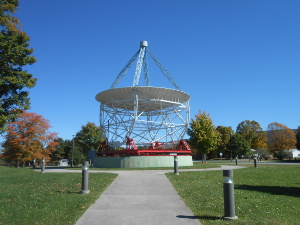 Green Bank Visitor Center
later learned were also the least populated parts of the state, near the Blue Ridge Mountains of Virginia.
Green Bank Visitor Center
later learned were also the least populated parts of the state, near the Blue Ridge Mountains of Virginia.
Today we drove beautiful back roads through lovely parts of West Virginia which we  Green Bank Visitor Center
later learned were also the least populated parts of the state, near the Blue Ridge Mountains of Virginia.
Green Bank Visitor Center
later learned were also the least populated parts of the state, near the Blue Ridge Mountains of Virginia.
We took turns driving and didn't see much besides a few not-so-prosperous homes and farms and gorgeous fall color and farm critters and one lone deer fawn in the middle of the road who dutifully jumped back in the woods which were so lacking in underbrush that it was easy to still see the deer among the trees.
Then Bob noticed a possible tourist stop along the way at the National Radio Astronomy Observatory, recently renamed the Green Bank Observatory, so we stopped for the bus tour.
Their biggest thing is the Green Bank Telescope, a 300 plus feet parabolic reflector and eight different custom made radio receivers in eight different frequency bands (the observatory says it is the state of the art in radio receivers) which are  Powerful new radiotelescope
supercooled as low as less than one degree above absolute zero using liquid helium.
Powerful new radiotelescope
supercooled as low as less than one degree above absolute zero using liquid helium.
These are radio telescopes designed to find signals emitted from objects unimaginable distances away from earth. They have been working for several decades now, becoming better as technology improved. Now they can be tuned to search particular areas of space looking for suspected objects, and the computers in these labs can begin to handle the continual data streams the telescopes collect.
Will they find life on other planets? They are definitely looking!
A large reason for placing this lab where it is, is that this is one of the least populated areas in the country. Surrounded by mountains and forests, this is land that is rugged and not suitable for farming and not near any popular destination. But students and astronomers come from all over the world to use these facilities. Originally established by the National Science Foundation, it is now a privately funded organization.
The surrounding hundred miles give or take of land are, by act of Congress, a "quiet zone", a radio-free zone, meaning that there is no cell phone service or electric  First radiotelescope
fences or heavy-duty battery power of most any kind. The vehicles at the lab, including the bus for our tour, have been specially designed not to use spark plugs (we were warned to turn off all digital devices, and there were antennas that would note anything sending out signals). The lab technicians work with local residents whenever they find some interference to control the radio emissions (intentional or otherwise) so that they don't come near the telescopes!
First radiotelescope
fences or heavy-duty battery power of most any kind. The vehicles at the lab, including the bus for our tour, have been specially designed not to use spark plugs (we were warned to turn off all digital devices, and there were antennas that would note anything sending out signals). The lab technicians work with local residents whenever they find some interference to control the radio emissions (intentional or otherwise) so that they don't come near the telescopes!
We saw the first-ever radio telescope, built by Grote Reber in 1937, in his mother's back yard in Wheaton, Illinois, from parts bought at the local hardware store. For more than ten years it was the only radio telescope in the world, because nobody else believed it had any use. Now it sits at the entrance to the lab property, part of the collection of telescopes that represent the growing capabilities of this field.
It is such a good lesson: science and art and all creative activity can take place just about anywhere.